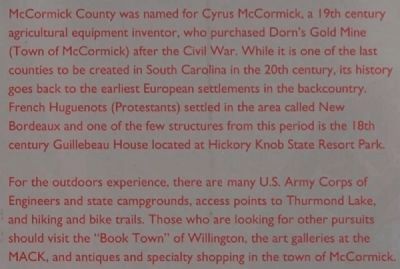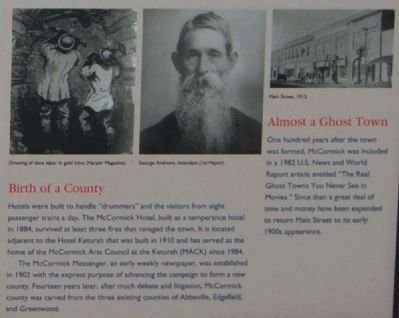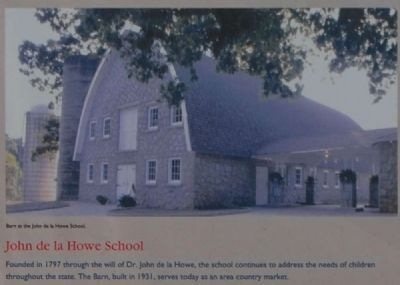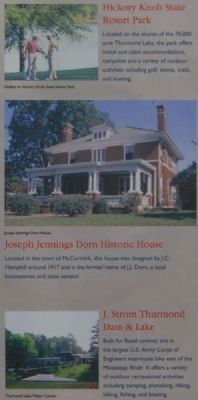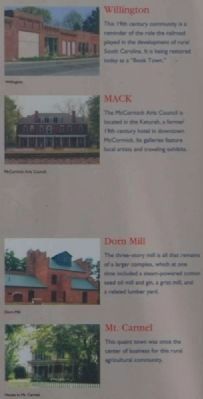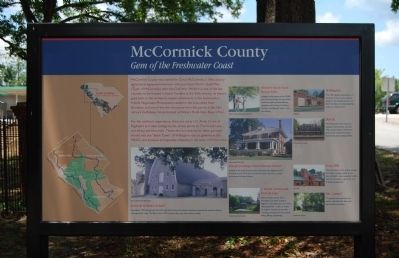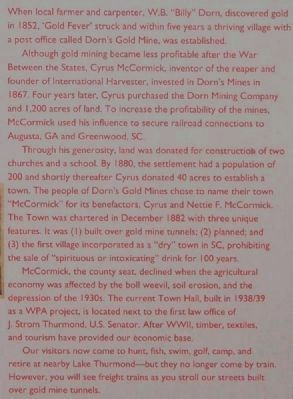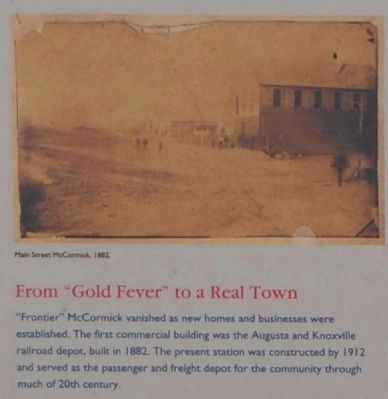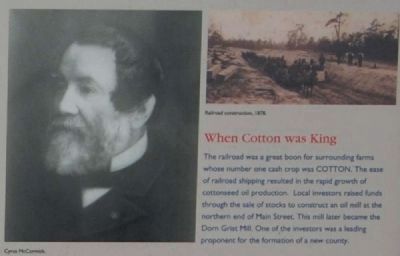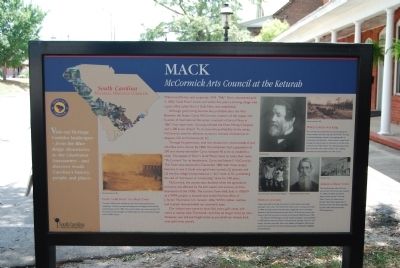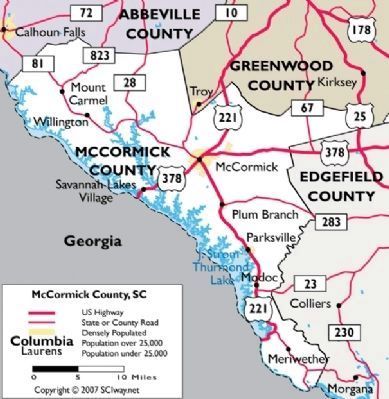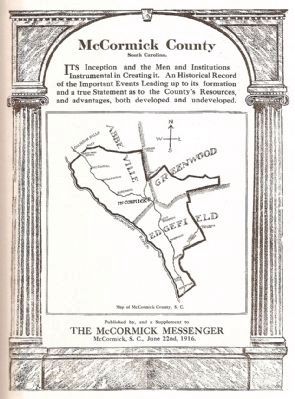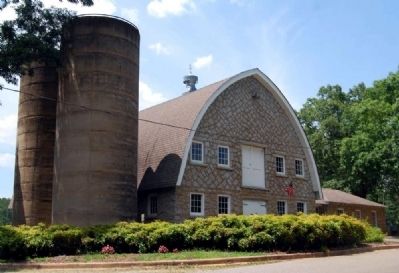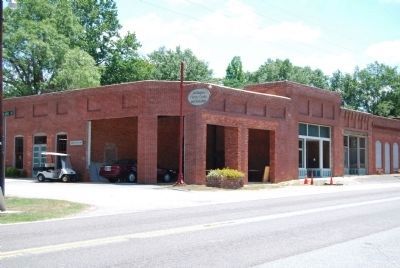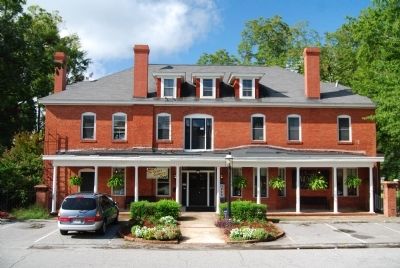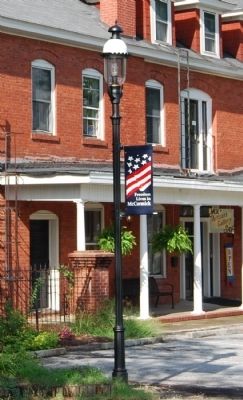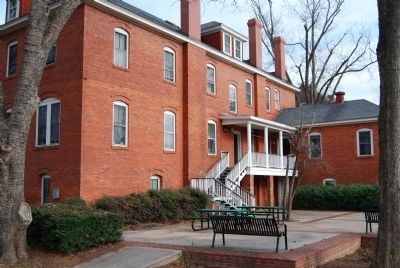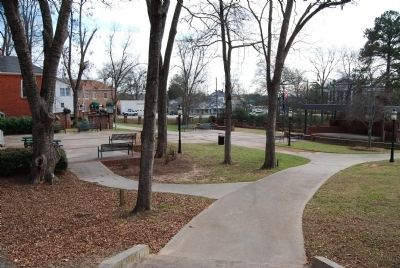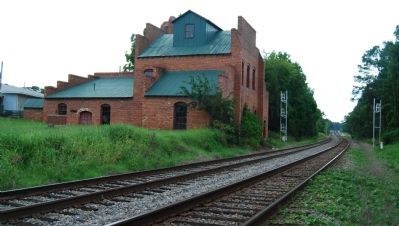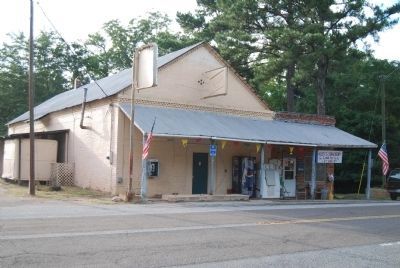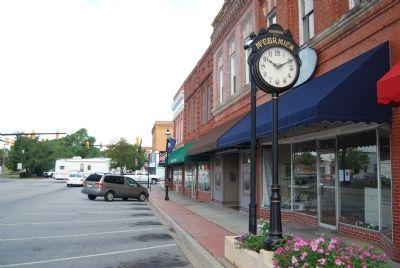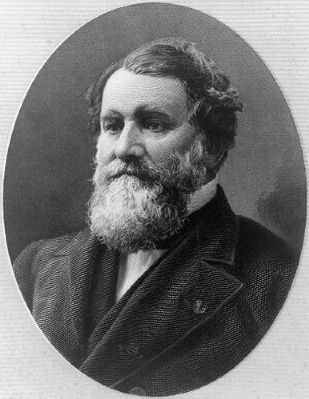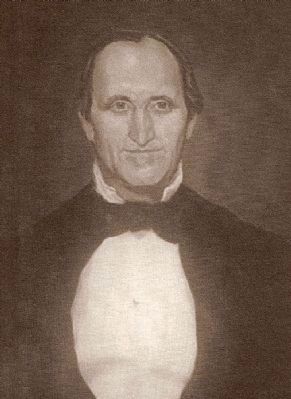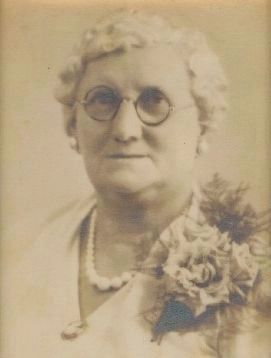McCormick in McCormick County, South Carolina — The American South (South Atlantic)
McCormick County / MACK
McCormick County: Gem of the Freshwater Coast
McCormick County was named or Cyrus McCormick, a 19th century agricultural equipment inventor, who purchased Dorn's Gold Mine (Town of McCormick) after the Civil War. While it is one of the last counties to be created in South Carolina in the 20th century, its history goes back to the earliest European settlements in the backcountry. French Huguenots (Protestants) settled in the area called New Bordeaux and one of the few structures from this period is the 18th century Guillebeau House located at Hickory Knob State Resort Park.
For the outdoors experience, there are many U.S. Army Corps of Engineers and state campgrounds, access points to Thurmond Lake, and hiking and bike trails. Those who are looking for other pursuits should visit the "Book Town" of Willington, the art galleries at the MACK, and antiques and specialty shopping in the town of McCormick.
John de la Howe School
Founded in 1797 through the will of Dr. John de la Howe, the school continues to address the needs of children throughout the state. The Barn, built in 1931, serves today as an area country market.
Hickory Knob State Park
Located on the shores of the 70,000 acre Thurmond Lake, the park offers motel and cabin accommodations, campsites and a variety of outdoor activities including gold, tennis, trails, and boating.
Joseph Jennings Dorn Historic House
Located in the town of McCormick, this house was designed by J.C. Hemphill around 1917 and is the former home of J.J. Dorn, a local businessman and state senator.
J. Strom Thurmond Dam & Lake
Built for flood control, this is the largest U.S. Army Corps of engineers man-made lake east of the Mississippi River. It offers a variety of outdoor recreational activities including camping, picnicking, hiking, biking, fishing, and boating.
Willington
This 19th century community is a reminder of the role the railroad played in the development of rural South Carolina. It is being restored today as a "Book Town."
MACK
The McCormick Arts Council is located in the Keturah, a former 19th century hotel in downtown McCormick. Its galleries feature local artists and traveling exhibits.
Dorn Mill
The three-story mill is all that remains of a larger complex, which at one time included a steam-powered cotton seed oil mill and gin, a grist mill, and a related lumber yard.
Mt. Carmel
This quaint town was once the center of business for this rural agricultural community.
MACK: McCormick Arts Council of Keturah
When local farmer and carpenter W.B. "Billy" Dorn, discovered gold in 1852, "Gold Fever" struck and within five years a thriving village with a post office called Dorn's Gold Mine, was established.
Although gold mining became less profitable after the War Between the States, Cyrus McCormick, inventor of the reaper and founded of international Harvester, invested in Dorn's Mine in 1867. Four years later, Cyrus purchased the Dorn Milling Company and 1,200 acres of land. To increase the profitability of the mines, McCormick used his influence to secure railroad connections to Augusta, GA and Greenwood SC.
Through his generosity, land was donated for construction of two churches and a school. By 1880, the settlement had a population of 200 and shortly thereafter Cyrus donated 40 acres to establish a town. The people of Dorn's Gold Mines chose to name their town "McCormick" for its benefactors, Cyrus and Nettie F. McCormick. The town was chartered in December 1882 with three unique features. It was (1) build over gold mine tunnels; (2) planned; and (3) the first village incorporated as a "dry" town in SC, prohibiting the sale of "spirituous or intoxicating" drink for 100 years.
McCormick, the county seat, declined when the agricultural economy was affected by the boil weevil, soil erosion, and the depression of the 1930s. The current Town Hall, built in 1938/39 as a WPA project, is located next to the first law office of J. Strom Thurmond, U.S. Senator. After WWII, timber, textiles, and tourism have provided our economic base.
Our visitors now come to hunt, fish, swim, golf, camp, and retire at nearby Lake Thurmond -- but they no longer come by train. However, you will see freight trains as you stroll our streets built over gold mine tunnels.
From "Gold Fever" to a Real Town
"Frontier" McCormick vanished as new homes and businesses were established. The first commercial building was the Augusta and Knoxville railroad depot, built in 1882. The present station was constructed by 1912 and served as the passenger and freight depot for the community through much of 20th century.
When Cotton was King
The railroad was a great boon for surrounding farms whose number one cash crop was Cotton. The ease of railroad shipping resulted in the rapid growth of cottonseed oil production. Local investors raised funds through the sale of stocks to construct an oil mill at the northern end of Main Street. This mill later became the Dorn Grist Mill. One of the investors was a leading proponent for the formation of a new century.
Birth of a County
Hotels were built to handle "drummers" and the visitors form eight passenger trains a day. The McCormick Hotel, built as a temperance hotel in 1884,
survived at least three fires that ravaged the town. It is located adjacent to the Hotel Keturah that was built in 1910 and has served as the home of the McCormick County Arts Council at the Keturah (MACK) since 1984.
The McCormick Messenger, an early weekly newspaper, was established in 1902 with the express purpose of advancing the campaign to form a new county. Fourteen years later, after much debate and litigation, McCormick County was carved from the three existing counties of Abbeville, Edgefield, and Greenwood.
Almost a Ghost Town
One hundred years after the town was formed, McCormick was included in a 1982 U.S. News and World Report article entitled "The Real Ghost Towns You Never See in Movies." Since then a great deal of time and money have been expended to return Main Street to its early 1900s appearance.
Erected by South Carolina Heritage Corridor.
Topics and series. This historical marker is listed in these topic lists: Agriculture • Churches & Religion • Horticulture & Forestry • Industry & Commerce • Settlements & Settlers • War, World II. In addition, it is included in the South Carolina Heritage Corridor, and the Works Progress Administration (WPA) projects series lists. A significant historical month for this entry is December 1882.
Location.
33° 54.75′ N, 82° 17.683′ W. Marker is in McCormick, South Carolina, in McCormick County. Marker is on North Main Street. Marker is located near the front entrance to the MACK. Touch for map. Marker is in this post office area: Mc Cormick SC 29835, United States of America. Touch for directions.
Other nearby markers. At least 10 other markers are within 6 miles of this marker, measured as the crow flies. McCormick Passenger Train Steps (about 300 feet away, measured in a direct line); Dorn Mill Complex (about 400 feet away); Dorn Mill (about 400 feet away); McCormick Train Station (about 700 feet away); McCormick County Veterans Monument (about 700 feet away); Dorn’s Mill / Dorn Gold Mine (about 800 feet away); McCormick County Confederate Monument (approx. 0.2 miles away); Badwell / Badwell Cemetery (approx. 2.4 miles away); Welcome to Baker Creek State Park (approx. 4.2 miles away); Long Canes Massacre (approx. 5.2 miles away). Touch for a list and map of all markers in McCormick.
Also see . . .
1. McCormick County, Gem of the Freshwater Coast. Official website of McCormick County. (Submitted on September 12, 2008, by Brian Scott of Anderson, South Carolina.)
2. McCormick County. McCormick County is a county located in the U.S. state of South Carolina. (Submitted on September 12, 2008, by Brian Scott of Anderson, South Carolina.)
3. McCormick, South Carolina. McCormick is a town in McCormick County, South Carolina, United States. (Submitted on November 25, 2009, by Brian Scott of Anderson, South Carolina.)
4. Lake Strom Thurmond. Lake Strom Thurmond, known in Georgia as Clarks Hill Lake, is a reservoir at the border between Georgia and South Carolina in the Savannah River Basin. (Submitted on November 25, 2009, by Brian Scott of Anderson, South Carolina.)
5. Willington, South Carolina. Willington is a census-designated place (CDP) in McCormick County, South Carolina, United States. (Submitted on November 25, 2009, by Brian Scott of Anderson, South Carolina.)
6. Hotel Keturah. The Hotel Keturah is a two-and-one-half-story brick building constructed ca. 1910 in the Colonial Revival style. (Submitted on November 25, 2009, by Brian Scott of Anderson, South Carolina.)
7. Joseph Jennings Dorn House. The Joseph Jennings Dorn House was built ca. 1917 in the Colonial Revival style and is one of the few early brick homes in McCormick. (Submitted on November 25, 2009, by Brian Scott of Anderson, South Carolina.)
8. Dorn Gold Mine. The Dorn Gold Mine is an area of nineteenth century mining operations consisting of horizontal shafts, vertical pits and a larger trench which extends approximately 200 feet. (Submitted on November 25, 2009, by Brian Scott of Anderson, South Carolina.)
9. Dorn's Flour and Grist Mill. Dorn’s Flour and Grist Mills is a two-and-a-half story red brick structure with projecting one-story wings. (Submitted on November 25, 2009, by Brian Scott of Anderson, South Carolina.)
10. Mount Carmel Historic District. Mount Carmel is a small town that developed in the 1880s, contemporary with the development of the Savannah Valley Railroad. (Submitted on November 25, 2009, by Brian Scott of Anderson, South Carolina.)
11. Guillebeau House. The Guillebeau House is a good example of Southern eighteenth-century pioneer construction. (Submitted on November 25, 2009, by Brian Scott of Anderson, South Carolina.)
12. Cyrus McCormick. Cyrus Hall McCormick, Sr. (February 15, 1809 – May 13, 1884) of Rockbridge County, Virginia was an American inventor and founder of the McCormick Harvesting Machine Company, which became part of International Harvester Company in 1902. (Submitted on November 25, 2009, by Brian Scott of Anderson, South Carolina.)
13. Town of McCormick, SC. Official website of the Town of McCormick, SC. (Submitted on December 18, 2009, by Brian Scott of Anderson, South Carolina.)
Additional commentary.
1. Creation of the County
Before the turn of the century keen interest developed {especially in the Town of McCormick} to form a new county. At the 1895 Constitution Convention "new county" leaders mounted an organized effort to form a county from parts of Abbeville and Edgefield counties· with the Town of McCormick as the county seat. A committee was appointed and sent before the constitution convention. The committee failed to accomplish its purpose.
During the following nine years there was a concentrated effort to form a new county.
A weekly newspaper The McCormick Messenger was established in 1902 with the express purpose of advancing the campaign for forming a county.
Surveyor L.P. Elam of Lincolnton, Georgia, completed a survey in 1902, to layout definite boundaries.
In 1904, in response to an application made by the new county group, the Governor authorized an election in the territory affected. The county movement carried in the election by a large majority, but when the bill went to the legislature it died in committee, the reason given that it did not meet minimum qualification as to size set for a county.
The proposed county could not obtain enough area from Abbeville and Edgefield without reducing them to below minimum area required by law. In seeking additional land area the new county leaders turned to Greenwood, but were advised that no territory could be taken from a "new" county.
The new county leaders carried their case to the Supreme Court to determine what was "new" and what was "old." The court ruled that Greenwood was indeed an "old" county. having been formed in 1897.
Application was again made to hold yet another election. The Governor ordered a new election in 1913. The county effort again carried, but an opposition group appealed the election result to the Supreme Court on the basis of a technical point that asserted all election laws had not being complied with. The court ruled in favor of the group that opposed formation of the new county.
In 1915 an election was ordered, and for the third time the movement to form a new county carried by a large majority. And yet again the opposition contested the election in court, but the election this time was upheld by the Supreme Court. McCormick County became a reality April 12, 1916, after a fight of twenty-one years. (Source: The Making of McCormick County by Bobby F. Edmonds (1999), pg 395.)
— Submitted December 18, 2009, by Brian Scott of Anderson, South Carolina.
2. Description of the De La Howe School
The American Farmer
1831
We have no information of the character of the deceased, nor of his wealth or will, but what is contained in an advertisement which we find in a South Carolina paper. By this advertisement it appears that provision is made in the will of the late John De La Howe for the education of twenty-four poor children, twelve boys and twelve girls. The trustees appointed to carry the will into effect, advertise for a teacher to superintend a farm school as planned and provided for in the will of the deceased. They have provided a good farm, suitable buildings, utensils, provisions and necessary stock, and offer a liberal salary for a teacher. According to the plan of the school in the will, the children will live together in one family, and the expenses are to be defrayed out of the funds of the estate with the addition of the labor of the children on the farm.
— Submitted December 18, 2009, by Brian Scott of Anderson, South Carolina.
3. Joseph Jennings Dorn House
The Joseph Jennings Dorn House was built ca. 1917 in the Colonial Revival style and is one of the few early brick homes in McCormick. The house is two stories with the main facade oriented towards Gold Street. On the main (south) facade is a one-story porch with paired Ionic columns resting on brick piers. Below the eave of the roof are large modillion blocks. On the east facade the porch extends to form an open port-cochere with extended roof brackets. The house is three bays wide and of Flemish bond brick construction. On the central bay of the first floor is the main entrance which features Corinthian motif pilasters and a dentilled cornice. Windows on the flanking bay of the first story and on the central bay of the second story are of tri-part design with both sash and casement windows. Other windows in the house are twelve-over-one sash. at the roofline is a hipped dormer with casement windows. The entire roof has a sheathing of terra-cotta tiles. The house has two prominent exterior chimneys with corbelled brick decoration. The interior of the house has been restored in recent years and displays the original staircase, wainscoting and decorative woodwork. At the rear of the house is a one-story brick garage built ca. 1917.
Significance
The house was built by Joseph Jennings Dorn, a prominent businessman and politician. Jennings Dorn was a great-nephew of gold miner William Dorn and owned many large farms in the McCormick vicinity in the early 1900s. Dorn was co-owner of the McCormick Manufacturing Company, Dorn Lumber Company and president of the Dorn Banking Company. Around 1917 Dorn commissioned architects J.E. Summer and J.C. Hemphill of Greenwood to design this house in McCormick. Upon its completion the house was one of the largest and most ornate in the community. In 1917 Dorn purchased the McCormick cotton seed oil mill along with his brother Martin Gary Dorn and Preston Finley. This mill complex was one of the
major industries in the community, and the Dorn brothers operated the mill for many years. In 1930 Jennings Dorn was elected to the state senate and served until 1936 when he was killed in an automobile accident. Following his death the property remained in the Dorn family until its purchase and restoration in recent years by the Sexton family. (Source: National Register nomination form.)
— Submitted December 18, 2009, by Brian Scott of Anderson, South Carolina.
4. Hotel Keturah
The Hotel Keturah is a two-and-one-half-story brick building constructed ca. 1910. The building is situated on a lot on Main Street facing the commercial row and railroad tracks. On the main (east) facade is a one-story frame and glass double doors with sidelights and transom. Adjacent to the entrance is a projecting bay with three two-over-two sash. A second bay window is located on the north facade of the first floor. On the second story is a door with sidelights which leads to the roof of the porch. The roof porch originally displayed a balustrade, but this has been removed. The building features a hipped roof with three prominent exterior chimneys and hipped dormers with two-over-two sash windows. The interior of the hotel has been restored in recent years and retains many of its original features.
Significance
The first Hotel Keturah was built by 1900 on this site. It was a two-story frame structure and stood until 1909, when it burned. The present building was constructed ca. 1910 to accommodate travelers and train passengers. Both hotels were constructed by W.J. Conner, who gave them his wife's name. A 1916 article in the McCormick Messenger describe the Keturah as a "new, modern commercial hotel." During its heyday the Keturah was managed by the Conners and was a favorite stopping point for salesmen and other travelers. The hotel remained in operation for many years until it closed in the 1960s. The building stood vacant until 1982 when it was purchased and restored by Mr. O.S. Sexton. The Keturah is one of the commercial landmarks of downtown McCormick and has not been greatly altered.
Other Information
The Hotel Keturah is presently being considered for use as an arts center by citizens of McCormick. (Source: National Register nomination form.)
— Submitted December 18, 2009, by Brian Scott of Anderson, South Carolina.
5. Dorn's Flour and Grist Mill
Dorn's Flour and Grist Mill is a 2 1/2-story red brick structure with projecting one-story wings. Constructed ca. 1898 as a cotton gin, the mill is an outstanding example of rural industrial architecture. The extant steam engines and boilers date from the period when the building was used as a cotton gin, but the grist mill equipment dates from the 1920s.
Stepped parapets are incorporated on both one and two story sections. The corners of the building are further supported by angle buttresses. Wide-gabled dormers on both the east and west facades project from the standing-seam tin roof. Dominant feature of the exterior is a three-story brick wall of cross-shaped plan which was built in 1915 to support a water tower. The tower provided back-up pressure for the boilers in case the steam water ejector pump failed. The tank has since fallen from its support, thereby causing extensive damage to the west wing.
From the railroad siding on the north side of the mill, hopper cars were loaded with grain and corn. A wooden channel extended from the 2nd floor of the elevator through the wall and over the siding. The exterior portion of this channel has since collapsed.
Exterior door and window openings are surmounted by segmental brick arches of two and three header courses. Window sashes are six-over-six lights, all of which are either missing or badly deteriorated.
The interior of the mill is its most salient feature. It is divided into five rooms on the first floor with two rooms in the upper section of the elevator. The structural system consists of 12" x 12" columns with chamfered edges supporting ceiling joists of the same dimensions. The exterior brick walls are load bearing, and all of the interior framework is exposed.
The southeast room houses the power plant for the mill: two one-cylinder steam engines and their boilers. These engines provided a source of power which was reliable, easily regulated, and cheap to operate. Dorn's Mill utilized wood chips from a local lumber yard for fuel. Both the steam engines and their boilers are intact, but the roof in this area of the building is deteriorating due to the collapse of the boiler exhaust stacks
The principal room of the mill is located on the first floor of the elevator section. In this area are located two large mill stones encased in a wooden platform, various pulleys and belts encased in wooden shafts, the grain cleaners, and the sacking machinery. The majority of this equipment is not encased, thereby exposing the thousands of mechanical components. The equipment that is enclosed is encased in wooden housings exhibiting fine quality mouldings and craftsmanship. The second floor features a flour dresser which separated the different grades of flour, and a corn cleaner which removed objects from the corn.
The shed room located east of the elevator housed the cotton oil machinery. The south wall of this room has collapsed, thus exposing the
intricate machinery to the weather. The room west of the elevator contains six grain storage bins, but the roof is deteriorating due to the collapse of the water tank.
Significance
At one time many small towns throughout rural America utilized the services of mills similar to Dorn's Mill in McCormick, South Carolina. With the development of a more complex mill technology, many of these mills disappeared. Dorn's Mill is significant as one of only a few such mills still standing--its steam engines, boilers, and most of its machinery still intact.
Peter Cousins, Curator of Agriculture at Greenfield Village and Henry Ford Museum says:
"Dorn's Mill represents the rural locally based grist mill in adaptation to the new technology of milling. The irony, of course, is that the complexity and cost of modern milling led to the concentration of the industry...and the ultimate demise of small mills in other areas--such as Dorn's."
The actual construction date for Dorn's Mill is not known; however, there is evidence of its being built ca. 1898. Deeds are available which indicate a sale from a Mrs. McCormick to McCormick Enterprise Ginnery, Ca. (l898). In 1899 the property was purchased by the McCormick Cotton Oil Company; in 1902 by the Anderson Phosphate Company. In 1914 the "oi1 mill and ginnery p1ant" were sold to the Farmers Gin Co. In 1917 this property was conveyed to M.G. Dorn, J.S. Dorn, and Preston Findley who formed the Dorn-Findley Corporation. Its general purpose was to "operate, conduct and carry on an oil mill, cotton gin and grist mill." In the mid 1920s the Dorns hired a mill wright to put in the present corn and wheat machinery as well as a hammer mill.
The mill operated throughout the years and ground commercial corn meal for sale in local and country stores, flour from wheat for local farmers (not for commercial sale) and chicken and animal feed.
The mill required one person to fire the boilers and operate the machinery. The boilers were fired with wood shavings brought by wagon from the planer mill and dumped through the large doors into the boiler room. Another person handled the milling operation weighing farmer's grain, grinding and sacking commercial meal, etc.
The mill closed in the 1940s. (Source: National Register nomination form.)
— Submitted December 18, 2009, by Brian Scott of Anderson, South Carolina.
6. About Cyrus Hall McCormick
Cyrus Hall McCormick, the famous inventor and manufacturer, was born at Walnut Grove, Virginia, February 15,1809. When he was seven years old his father invented a reaping machine. It was a rude contrivance and not successful. In 1831 Cyrus made his invention of a reaping machine, and had it patented three years later. By successive improvements he was able to keep his machines at the head of its class during his life. In 1845 he removed to Cincinnati, Ohio, and two years later located in Chicago, where he amassed a great fortune in manufacturing reapers and harvesting machinery. In 1859 he established the Theological Seminary of the Northwest at Chicago, an institution for preparing young men for the ministry in the Presbyterian church, and he afterward endowed a chair in the Washington and Lee College at Lexington, Virginia. He manifested great interest in educational and religious matters, and by his great wealth he was able to extend aid and encouragement to many charitable causes. His death occurred May 13, 1884. (Source: A Biographical Record of Calhoun County, Iowa by S. J. Clarke Publishing Company (1902), pg 172.)
— Submitted December 18, 2009, by Brian Scott of Anderson, South Carolina.
Credits. This page was last revised on September 17, 2020. It was originally submitted on September 12, 2008, by Brian Scott of Anderson, South Carolina. This page has been viewed 3,110 times since then and 31 times this year. Photos: 1, 2, 3, 4, 5. submitted on November 25, 2009, by Brian Scott of Anderson, South Carolina. 6. submitted on September 12, 2008, by Brian Scott of Anderson, South Carolina. 7, 8, 9. submitted on November 25, 2009, by Brian Scott of Anderson, South Carolina. 10. submitted on September 12, 2008, by Brian Scott of Anderson, South Carolina. 11. submitted on November 29, 2009, by Brian Scott of Anderson, South Carolina. 12. submitted on December 18, 2009, by Brian Scott of Anderson, South Carolina. 13. submitted on July 17, 2009, by Brian Scott of Anderson, South Carolina. 14. submitted on July 20, 2008, by Brian Scott of Anderson, South Carolina. 15, 16. submitted on September 13, 2008, by Brian Scott of Anderson, South Carolina. 17, 18. submitted on January 1, 2009, by Brian Scott of Anderson, South Carolina. 19. submitted on September 12, 2008, by Brian Scott of Anderson, South Carolina. 20. submitted on September 21, 2008, by Brian Scott of Anderson, South Carolina. 21. submitted on September 13, 2008, by Brian Scott of Anderson, South Carolina. 22. submitted on November 25, 2009, by Brian Scott of Anderson, South Carolina. 23. submitted on December 8, 2009, by Brian Scott of Anderson, South Carolina. 24. submitted on December 18, 2009, by Brian Scott of Anderson, South Carolina. • Craig Swain was the editor who published this page.
